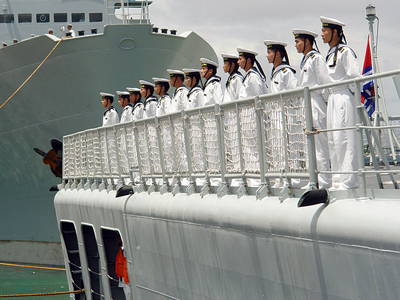China's Blue-Water Ambitions
China is not going to field a navy with a global reach anytime soon. But its attempts to do so could touch off a new arms race.
 The Chinese Communist Party (CCP) derives much of its legitimacy from ensuring stellar economic growth. This kind of rapid expansion is resource intensive, and those who admire the CCP’s record should not discount the role secure energy supply lines play in maintaining the political status quo—now more than ever, as Beijing’s quest for oil, metal and minerals takes it far from its shores.
The Chinese Communist Party (CCP) derives much of its legitimacy from ensuring stellar economic growth. This kind of rapid expansion is resource intensive, and those who admire the CCP’s record should not discount the role secure energy supply lines play in maintaining the political status quo—now more than ever, as Beijing’s quest for oil, metal and minerals takes it far from its shores.
As China develops complex economic and strategic interests in Africa and the Middle East, freedom of navigation through the Indian Ocean and much of the Pacific will concern Beijing mightily. But unsurprisingly, there is discomfort with sharing maritime security responsibilities close to home. Considering the relative strength of those patrolling the waters—mainly Japan and the United States—the Chinese fear that in times of crisis, access to critical sea lines of communication could be blocked. Or worse, Beijing might be forced to compromise on its long-held logic of sovereignty over a region that extends far beyond what international law permits.
Before it can dominate the seas, China has much catching up to do. The combined weight of twenty-one of the world’s biggest navies is 6.75 million tons. Remove the United States Navy (USN), and that leaves the global fleet 46 percent lighter at about 3.63 million tons. Though not the most accurate gauge of naval prowess, the skewered weight distribution—combined with the USN’s pound-for-pound superiority—cannot bode well for a rising power wary of the status quo.
Unfortunately, what China has to show for three decades of naval modernization are a handful of nuclear-powered attack- and ballistic-missile submarines that lag behind those of the world’s premier navies, an aircraft carrier they’re only beginning to learn how to use and antiship ballistic missiles (ASBM).
Only the ASBM really gives Beijing an edge over the competition. The Pentagon reports the highly maneuverable missile has a range of one thousand miles. Considering even the next generation of naval fighter aircraft will lack the range to return to their carriers if launched further than six hundred miles from their intended target, denying potential adversaries access to a significant portion of the Western Pacific looks possible.
But for the near future, blue-water ambitions are likely to remain unfulfilled. A refurbished Soviet-era aircraft carrier, ASBMs and a few unstealthy nuclear submarines won’t allow the People’s Liberation Army Navy (PLAN) to conduct complex operations far from its shores, even if China’s sailors can master their new boats.
Given the bulk of what the PLAN presently fields, the implications are likely to be felt closer to home. The large fleet of Song, Ming and Romeo class diesel-electric submarines, catamarans, Landing Platform Docks, and other short-range and shore-based weapons will influence the day-to-day choices nearby countries will make—especially whether to align more closely with China or the United States.
China is eager to see its maritime neighbors embrace its naval-modernization effort. Such support is now vital after the apparent loss of Burma as an alternative energy corridor, which has led some in Beijing to question the prudence of banking on vastly expensive and highly tenuous relationships to secure resources.
But if China feels inclined to continue engaging in brinkmanship of the sort seen in the Scarborough shoal standoff, most are unlikely to warm to its naval ambitions. As those further away in India and Australia face a more capable PLAN, friendly rhetoric from Beijing will provide little reassurance. Japan and South Korea too would find it better to balance against China’s burgeoning capabilities—instead of hoping military planners in Beijing don’t act on their dissatisfaction with the status quo. Australia has already embarked on the initial stages of a $40 billion revamp of its submarine fleet. India recently took delivery of a Russian Akula class nuclear-powered attack submarine and is also building its own nuclear submarines as well as another aircraft carrier. Japan is enlarging its submarine fleet for the first time in thirty-six years. South Korea also is modernizing its naval and amphibious forces.
The cost of miscalculation here is high, and it is hard to see how such an environment could work in the China’s favor. Ostensibly, a stronger navy should allow Beijing to throw its weight around with greater ease. But if Chinese naval modernization is spurring others in the region to do the same—and if some of its more powerful neighbors look more than capable of playing catch-up—it is difficult to decipher what advantage the PLAN hopes to wield in the long term. Hegemony in the Pacific and Indian Oceans seems unlikely. Anything less could leave Beijing more isolated and vulnerable in a powerful, distrustful backyard.
Kailash K. Prasad is a research associate at the Delhi Policy Group, New Delhi. All views are his own.
